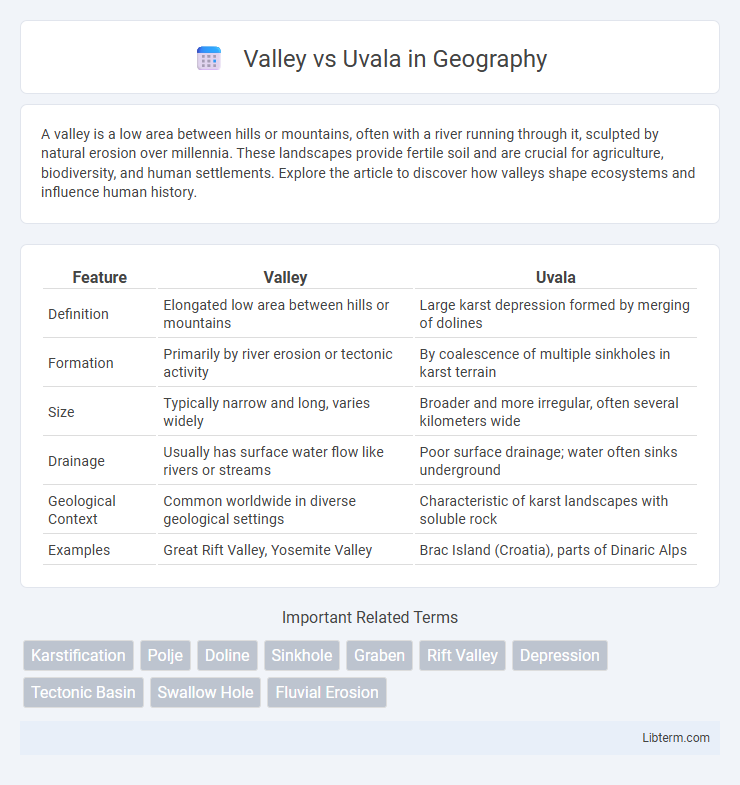A valley is a low area between hills or mountains, often with a river running through it, sculpted by natural erosion over millennia. These landscapes provide fertile soil and are crucial for agriculture, biodiversity, and human settlements. Explore the article to discover how valleys shape ecosystems and influence human history.
Table of Comparison
| Feature | Valley | Uvala |
|---|---|---|
| Definition | Elongated low area between hills or mountains | Large karst depression formed by merging of dolines |
| Formation | Primarily by river erosion or tectonic activity | By coalescence of multiple sinkholes in karst terrain |
| Size | Typically narrow and long, varies widely | Broader and more irregular, often several kilometers wide |
| Drainage | Usually has surface water flow like rivers or streams | Poor surface drainage; water often sinks underground |
| Geological Context | Common worldwide in diverse geological settings | Characteristic of karst landscapes with soluble rock |
| Examples | Great Rift Valley, Yosemite Valley | Brac Island (Croatia), parts of Dinaric Alps |
Introduction to Valleys and Uvalas
Valleys are elongated depressions formed primarily by river erosion, characterized by a distinct V-shape or U-shape depending on the formation process, and typically feature a continuous watercourse. Uvalas are larger karst depressions that form by the merging of multiple sinkholes or dolines, creating an irregular, basin-like landscape without a defined continuous stream. Both are integral to karst topography but represent different scales and processes of landform development.
Defining Valleys: Characteristics and Formation
Valleys are elongated depressions in the Earth's surface formed primarily through the erosive action of rivers or glaciers over geological timeframes. Characterized by gentle slopes and a distinct V or U-shaped cross-section, valleys funnel water and sediment from higher elevations to basins or seas. Their formation depends on factors such as rock type, climate, tectonic activity, and the nature of the erosive agent shaping the landscape.
Understanding Uvalas: Features and Development
Uvalas are large, closed depressions formed by the merging of multiple sinkholes or dolines, typically found in karst landscapes characterized by soluble rock such as limestone. Unlike valleys, which are shaped by surface water erosion, uvalas develop primarily through subterranean dissolution processes, leading to irregular, broad depressions with uneven floors and steep sides. These features often indicate advanced stages of karst development, providing insights into the area's geological history and hydrological dynamics.
Geological Processes Behind Valleys
Valleys primarily form through prolonged erosion by rivers, glaciers, or tectonic activity, shaping V-shaped or U-shaped profiles depending on the agent. River valleys develop narrow, V-shaped cross sections through consistent water erosion, whereas glacial valleys are broader and U-shaped due to ice movement and plucking. Uvalas arise from the coalescence of multiple sinkholes in karst landscapes, resulting from limestone dissolution and subsurface chemical weathering rather than surface erosion processes.
Geological Processes Behind Uvalas
Uvalas form through the merging and expansion of multiple sinkholes (dolines) primarily caused by the dissolution of soluble rocks such as limestone and gypsum in karst landscapes. This geological process involves groundwater eroding subterranean rock layers, leading to the collapse and coalescence of dolines into larger, irregular depressions distinct from the typically linear structure of valleys. The continuous chemical weathering and subsidence contribute to the characteristic broad, closed depressions of uvalas, highlighting complex subsurface hydrological dynamics absent in valleys formed mainly by surface water erosion.
Key Differences Between Valleys and Uvalas
Valleys are elongated depressions formed primarily by river erosion or glacial activity, characterized by their distinct V-shaped or U-shaped cross-sections and typically extending over long distances. Uvalas are large, irregularly shaped karst depressions resulting from the coalescence of multiple sinkholes, lacking significant surface water channels and often exhibiting a closed drainage system. Key differences include their formation processes--valleys through fluvial or glacial erosion versus uvalas through karst dissolution--and their morphology, with valleys being linear and uvalas being more expansive and rounded.
Similarities in Valley and Uvala Formation
Valleys and uvalas both form through the collapse of underground karst systems, involving the dissolution of soluble rocks like limestone that creates subsurface voids. Both features exhibit elongated depressions and are primarily shaped by chemical weathering and groundwater erosion processes. Their development reflects the gradual subsidence of surface materials as subterranean cavities expand and merge over time.
Notable Examples of Valleys Worldwide
The Grand Canyon in the United States, the deepest and most famous valley globally, showcases extensive erosion and dramatic geological formations. The Great Rift Valley in East Africa spans thousands of kilometers, hosting diverse ecosystems and significant archaeological sites. The Yosemite Valley in California offers iconic granite cliffs and waterfalls, made famous by its unique glacial valley shape and natural beauty.
Notable Examples of Uvalas Worldwide
Notable examples of uvalas worldwide include the Uvala Jureska in Croatia, characterized by its extensive karst depression and limited drainage system. The Uvala Domazet in Bosnia and Herzegovina showcases a significant uvala formation within the Dinaric Alps, illustrating classic karst geomorphology. These uvalas differ from valleys primarily in their broader, irregular shape and formation through the coalescence of multiple sinkholes, emphasizing their unique geological and hydrological features.
Significance of Valleys and Uvalas in Landscape Evolution
Valleys serve as key conduits for water flow, shaping erosion patterns and sediment deposition that drive landscape evolution over geological timescales. Uvalas, characterized by their larger, irregular depressions formed by the coalescence of multiple sinkholes, influence karst topography development and groundwater movement. Both valleys and uvalas play crucial roles in directing hydrological processes and shaping the geomorphology of a region.
Valley Infographic

 libterm.com
libterm.com